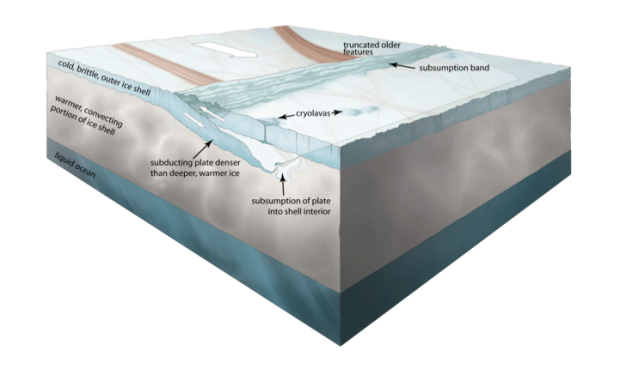The Carnival of Space 370 is up at the Venus Transit.
Plate tectonics may increase chances for life on Europa
The icy surface may be connected to the ocean below; plate tectonics can provide a way for nutrients to be carried from the surface down into the waters below, just as they do on Earth. Even microbes themselves might be able to make that journey.
Illustration depicting how plate tectonics may work on Europa. The cold, brittle outer ice shell overlies the warmer, lower ice shell which in turn sits on top of the subsurface ocean. Image Credit: Nature
Nature Geoscience – Evidence for subduction in the ice shell of Europa
Abstract on Europa Plate tectonics
Jupiter’s icy moon Europa has one of the youngest planetary surfaces in the Solar System, implying rapid recycling by some mechanism. Despite ubiquitous extension and creation of new surface area at dilational bands that resemble terrestrial mid-ocean spreading zones, there is little evidence of large-scale contraction to balance the observed extension or to recycle ageing terrains. We address this enigma by presenting several lines of evidence that subduction may be recycling surface material into the interior of Europa’s ice shell. Using Galileo spacecraft images, we produce a tectonic reconstruction of geologic features across a 134,000 square km region of Europa and find, in addition to dilational band spreading, evidence for transform motions along prominent strike-slip faults, as well as the removal of approximately 20,000 square km of the surface along a discrete tabular zone. We interpret this zone as a subduction-like convergent boundary that abruptly truncates older geological features and is flanked by potential cryolavas on the overriding ice. We propose that Europa’s ice shell has a brittle, mobile, plate-like system above convecting warmer ice. Hence, Europa may be the only Solar System body other than Earth to exhibit a system of plate tectonics.
19 pages of supplemental information
Nextbigfuture – Aquarius a nuclear thermal rocket that uses water heated to over 3000 degrees celsius to solve many human interplanetary transportation issues.Attributes of a reusable interplanetary human spaceflight transport are proposed and applied to example transits between the Earth/Moon system and Deimos, the outer moon of Mars. Because the transport is 54% water by mass at an interplanetary departure, it is christened Aquarius. In addition to supporting crew hydration/hygiene, water aboard Aquarius serves as propellant and as enhanced crew habitat radiation shielding during interplanetary transit. Key infrastructure and technology supporting Aquarius operations include pre-emplaced consumables and subsurface habitat at Deimos with crew radiation shielding equivalent to sea level on Earth, resupply in a selenocentric distant retrograde orbit, and nuclear thermal propulsion.
Advancing in-space nuclear thermal propulsion (NTP) technology to the point where fission reactor core temperatures exceeding 3000° C can be achieved during major translational maneuvers (burns). Under these conditions, water molecules pumped into the core will disassociate into hydrogen and oxygen atoms, and specific impulse ISP near 1000 s could be achieved. This level of efficiency, twice that attainable with chemical propulsion, dramatically reduces total mass for an interplanetary transport of specified payload mass.
Nextbigfuture – Spacex has over $3 Billion in backlog orders and $5 billion in orders to date.
• Diverse customer case
– over 50 Falcon 9/Heavy missions sold
– ~35% US Government
– ~65% Commercial
If you liked this article, please give it a quick review on ycombinator or StumbleUpon. Thanks

Brian Wang is a Futurist Thought Leader and a popular Science blogger with 1 million readers per month. His blog Nextbigfuture.com is ranked #1 Science News Blog. It covers many disruptive technology and trends including Space, Robotics, Artificial Intelligence, Medicine, Anti-aging Biotechnology, and Nanotechnology.
Known for identifying cutting edge technologies, he is currently a Co-Founder of a startup and fundraiser for high potential early-stage companies. He is the Head of Research for Allocations for deep technology investments and an Angel Investor at Space Angels.
A frequent speaker at corporations, he has been a TEDx speaker, a Singularity University speaker and guest at numerous interviews for radio and podcasts. He is open to public speaking and advising engagements.




